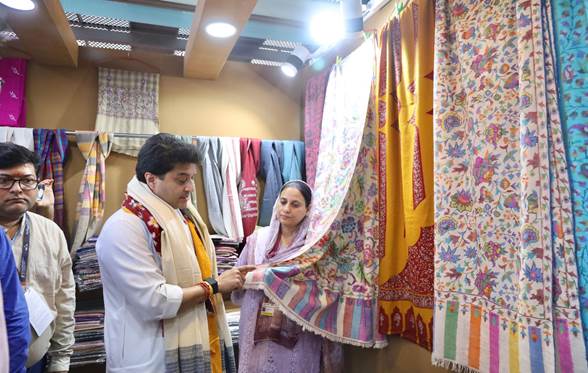Scindia visits cultural corridor focusing on advancement in handloom sector
The Union
Minister’s visit is concurrent to the ongoing ITU-WTSA 2024 to focus on technology’s
role especially in the North Eastern Region
The corridor beautifully combines India’s rich cultural traditions with its
technological advancements, captivating delegates from around the world.
The Minister
of Communications; and Minister of Development of North Eastern Region Shri.
Jyotiraditya M Scindia yesterday visited the vibrant Cultural Corridor which
has been set up at Bharat Mandapam to share a glimpse of India’s rich heritage
with thousands of international delegates participating in the ITU-WTSA 2024.
The corridor features exquisite handlooms and handicrafts from various corners
of the country, displayed and available for display and purchase at 14 stalls
organised by the Ministry of Textiles and Ministry of Development of North
eastern Region DONER.
The corridor also highlights technological advancements
in the handloom sector, particularly by the Northeastern Region (NER).
Delegates can experience India's technological leadership through its Digital
Public Infrastructure (DPI), which facilitates cashless transactions for goods
and services during the event via UPI services.
Another notable highlight of technology adoption is a
demonstration of NEHHDC’s (North Eastern Handicrafts & Handlooms
Development Corporation Ltd) case study on the application of Blockchain for
the Traceability of Eri cocoon “fibre to fashion” value chain. NEHHDC is working with LW3 to design and develop
Digital Product Passport for handloom sector that uses blockchain technology
and unique non cloneable QR codes to create a digital passport for handloom and
handicraft products using Eri silk cocoon as sustainable fibre. This passport
provides transparency, traceability, and authenticity, ensuring fair trade
practices and protecting the intellectual property of artisans and weavers. By
recording the product's journey, chain of custody, and consumer interaction
with the artisan and weaverd, LW3 empowers consumers to make informed choices
and supports a more ethical and sustainable market for handcrafted goods. The
platform also allows artisans to gain social recognition through positive
consumer feedback.
Additionally, the corridor features three stalls
dedicated to NEHHDC under MoDONER, showcasing handlooms and handicrafts from
the Northeastern states. Highlights include the Shaphee Lanphee from Manipur,
at the Handlooms of North Eastern Region stall. The Handicrafts of North
Eastern Region stall features items like cane sling bags and coin purses by
artist Mrs. Keisham Babita Devi from Manipur. Additionally, the Technology
Adoption in Handlooms of NER stall showcases Manipuri home textiles by National Awardee Smt. Indira Chirom and
provides insight into traditional Manipuri weaving techniques passed down
through generations. Textiles crafted on loin looms, throw shuttles, and fly
shuttle looms, including Enaphees and Moirangphees, are also on display.
Overall, The Cultural Corridor includes artisans who are National Awardees and skilled craftspeople,
presenting a diverse array of handloom and handicraft products from various
states, including Kutch shawls and Tangaliya weaves from Gujarat, Manipuri home
textiles, Kullu shawls from Himachal Pradesh, and Pochampally Ikat from
Telangana.
The visit was a part of the side events of the ongoing
WTSA 24 & IMC24 being held in New Delhi. The event marks the beginning of a
new chapter in India’s digital journey, reinforcing the country's commitment to
becoming a global leader in advanced communication technologies.
WTSA 2024, organised by the
International Telecommunication Union (ITU), serves as a platform for the
development and implementation of global telecommunications standards, uniting
regulators, industry leaders, and policymakers to shape the future of
communications worldwide.


